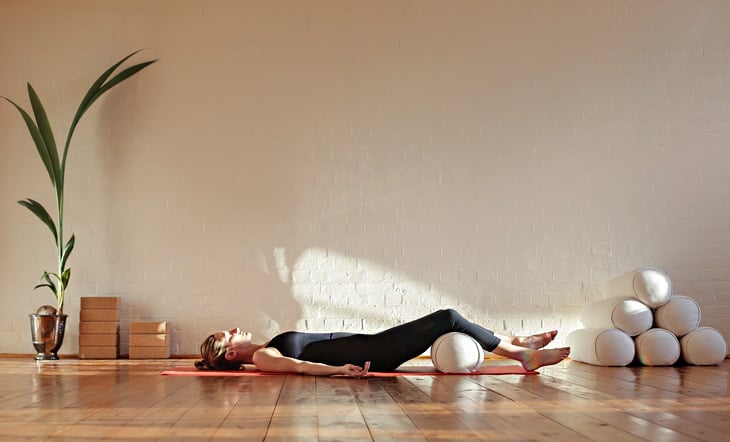
Yoga Nidra is a magical practice that is often translated as “yogic sleep.” Yogic sleep sounds pretty good, but what is Yoga Nidra exactly?
It’s an interesting practice that has roots dating back thousands of years. If you’ve ever been lucky enough to experience the practice, you know that the benefits of Yoga Nidra are plentiful and that the practice is soothing, restorative, and deeply restful.
Read on to find out everything about this mystical yogic sleep meditation and how to properly practice it.
Explore our online Yoga Nidra classes on YA Classes!
In addition to hundreds of other classes ranging from Vinyasa, Yin, meditation and more, we offer Yoga Nidra right here on YouAligned. 🙂
What Is Yoga Nidra?
This simple, restorative practice is a guided meditation that lulls you into a state of semi-consciousness. Through intention setting, body scans, visualizations, and breath awareness, you’re transferred to another world that is calm, soothing, and peaceful.
Yoga Nidra is believed to be deeply restorative and relaxing for the nervous system and as restful and soothing as sleep. It’s said that a short Yoga Nidra practice is as refreshing as hours of deep sleep.
A short Yoga Nidra practice is as refreshing as hours of deep sleep.
It’s undoubtedly a powerful practice, but it’s also one of the easiest meditations to follow and to consistently practice.
As a fully guided meditation, Yoga Nidra is practiced lying down on your back. This restful position allows you to fluctuate between conscious and semi-conscious states, moving you through different stages of awareness.
Via gently guided relaxation techniques, Yoga Nidra forces you to slow down, calm down, and inevitably restore.
Craving a different type of guided meditation? Try this Guided Pranayama and Mindfulness Meditation for a Calm and Peaceful Mind (Video)
The History of Yoga Nidra
Yoga Nidra is said to be as old as the practice of yoga itself.
First mentioned in the Upanishads (ancient holy scriptures of Hinduism and yogic philosophy) and then later discussed in the Mahabharata (the longest epic poem in the world, which includes the Bhagavad Gita), Yoga Nidra has undoubtedly been around for a long time.
The revered guru Satyananda Saraswati is said to be one of the first modern yoga teachers that really employed the practice of Yoga Nidra with his pupils.
Even more modernly, Richard Miller (a yoga teacher who has pioneered the idea of using yoga as a therapeutic practice) developed the iRest Yoga Nidra method as a modern adaptation of the ancient meditation practice of Yoga Nidra.
His method has been used across the world for various purposes, including helping soldiers returning home from war with Post Traumatic Stress Disorder (PTSD).
Mindfulness + PTSD: 5 Ways That Practicing Mindfulness Can Help Post Traumatic Stress Disorder
The Science Behind Yoga Nidra
Yoga Nidra has been studied scientifically with many promising results that show various benefits.
One study found that Yoga Nidra is characterized by a depressed level of desire for action. The study found decreased blood flow in the prefrontal, cerebellar, and subcortical regions of the brain while subjects were practicing Yoga Nidra. (These parts of the brain are believed to be associated with action.)
The study confirmed increased dopamine release during the Yoga Nidra meditation, which was also associated with the experience of reduced readiness for action.
Another study found that Yoga Nidra increased heart rate variability (HRV), which is often applied as an index of autonomic nervous system balance and, therefore, is a strong indicator of overall health.
Yoga Nidra has been studied scientifically with many promising results that show various benefits.
Another study measured the effects of a Yoga Nidra practice on university students’ self-esteem and stress levels. The findings indicated that Yoga Nidra could alleviate basic life stresses and improve overall self-esteem.
Another study measured brain activity during Yoga Nidra and found that subjects were in a deeply relaxed state (similar to the brain state of sleep) while practicing. What’s interesting is that these results also found participants to be in completely aware states while simultaneously in this deep relaxation.
Further studies have found Yoga Nidra to help reduce stress, improve pain management, cope with sexual assault, reduce drug addiction relapse, and more.
Follow These 7 Steps to Practice Yoga Nidra:
Traditional Yoga Nidra follows specific steps to reach the deeply restorative semi-conscious state. The following are typical steps of a Yoga Nidra practice.
1. Set Up Your Space
It’s important to get as comfortable as possible when practicing Yoga Nidra, so set up your space however you need to get relaxed and settled.
You may wish to use props like a yoga bolster under your back or your knees or to cover yourself with a blanket or place a pillow under your head. Adjust yourself however you need to in order to get really comfortable as you lie down to prepare for your practice.
Soften comfortably into a yoga mat, couch, or bed so that the position of your body won’t distract you during your practice.
2. Create a Sankalpa
A sankalpa is an intention, and it’s something that you probably already use in your asana practice.
Bring your awareness to whatever it is that your heart desires or what you hope to gain from this practice. Maybe you intend to cultivate hope or prosperity, or maybe your intention is simply to relax and restore.
Whatever your intention for the practice is, make it clear in your mind’s eye so that it can become the focal point of your meditation.
The Power of Sankalpa: Here’s Everything You Need to Know About Setting Intentions in Yoga
3. Scan Your Body
This step is far more than just a body scan. This stage of your Yoga Nidra practice is meant to move you into a state of Pratyahara (a withdrawal of the senses). Pratyahara is believed to be the gateway to the subconscious and that is the primary target of Yoga Nidra.
Pratyahara Explained: The Fifth Limb of the Yoga Sutras and the First Step Toward Meditation
So systematically move through your body and sense each and every part of it. Experience the sensations of your right big toe all the way down to your pinky toe. Really feel your hips, torso, and arms. Sense your throat, chin, lips, nose, eyes, and forehead.
Move across your whole body and, as you do so, systematically relax each part of your body as you sense it. Once you’ve fully relaxed your body, let it stay fully relaxed as you move your attention to more subtle parts of yourself.
4. Draw Your Awareness to Your Breath
Feel the movements of your breath. Feel your body breathing naturally. Dive into the deeper mechanics of your breath. Where does the air enter your body? Where does it exit? What is its texture, temperature, and speed?
Experience the tide of prana flowing through you. By drawing deeper into the subtleties of your body, you move farther and farther into deeper stages of Pratyahara.
As you follow the ebb and flow of your breath, let its rhythm lull you into a semi-conscious state.
Learn more about Prana: Demystifying Life Force Energy
5. Become Aware of Your Thoughts and Feelings
Become the mindful observer and simply notice thoughts and feelings as they arise. Without judgement, simply acknowledge what passes through your mind – whether consciously or not.
Avoid dwelling on any one thought or feeling that arises. Simply watch the cascade of thoughts pass through your mind.
6. Experience and Observe
Take notice of what has arisen from this whole experience. Become aware of the conscious observer that is always present, regardless of your emotional or physical state.
Connect with this higher awareness that dwells within you. Feel how this connects you to a greater consciousness beyond yourself.
7. Mindfully Resurface
When you’re ready, slowly and mindfully return to a state of heightened conscious awareness. Follow your own pace to reawaken and reorient to your waking life.
Pause for a moment to reflect back on your sankalpa and to find gratitude for your practice before moving on with your day.
Looking for more deeply restorative practices? Try These 4 Restorative Yoga Poses to Relax Your Body and Mind
What Is Yoga Nidra? The Takeaway on Yogic Sleep
The practice of Yoga Nidra is undoubtedly beneficial to the body, breath, and mind. By practicing this soothing meditation, you might find yourself feeling more rested, alert, or consciously aware.
Next, read: These 8 Benefits of Yoga Nidra Will Make You Want to Practice ASAP
Give the practice a try and see how you feel. You just may find that Yoga Nidra is your new favorite style of stress-relieving, restorative meditation.
This article has been read 1K+ times. Feelin’ the love!







